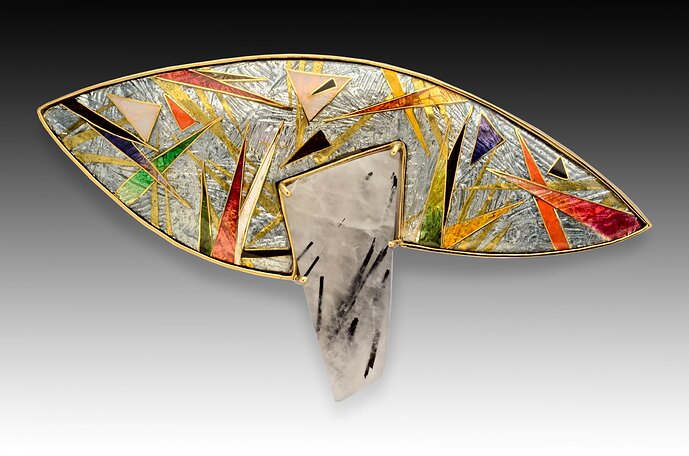Materials: Vitreous enamel, 24,22 & 18ct gold, fine *& sterling silver, rutilated quartz.
Dimensions: 10 x 5.5 cm
Cloisonee enamel, transparent enamel, bezel set, inspired by the stone within the piece.
Photo credit: Howard Birnstihl
Debbie Sheezel
debbiesheezel.com.au
Melbourne, Victoria. Australia
I trained as a painter with the Melbourne College of the Arts, not knowing I would end up at the jewellery bench. I discovered enamels accidentally. It was the brilliance of colour that captured me which became a passion. At first I used enamels as a medium with which to paint large panels.
Then, needing to know more about metals, I studied jewellery at RMIT University where I ended up teaching. I work mainly with the Cloisonee technique on fine silver and gold. The enamels are somewhat traditional but with a contemporary edge. I have been enamelling for over 45 years and have run the gamut of enamels, from huge murals like the 60 x 3 1/2 metre mural for the Arrivals Hall in the "Brisbane International Airport", many large 24inch enamel dishes for the Australian Government as gifts for dignitaries, to small collectible "one-off" pieces of "wearable art" jewellery. I have taught at RMIT for a number of years, was secretary of the Gold & Silversmiths Guild of Australia for many years and now teach workshops. I find inspiration from many areas but colour is my main inspiration. It could be a piece of stone, an image or something organic.
The exhibition explores metal works whose primary theme is color embraced as their primary visual focus, whether that be using colored materials, exploring creating colored surfaces, or encasing the object in color.
As the world's largest jewelry related internet site, Ganoksin strives to develop exhibitions showcasing work from around the world. This exhibition was open to all metalsmiths, professional and amateur, advanced and beginner.
In total 303 artists contributed 814 show pieces for the permanent online exhibition.
The exhibition was curated by Beth Wicker, President of the North Carolina Society of Goldsmiths in the United States, and Adjunct Instructor at Northeastern Technical College in South Carolina. Director of the exhibition is Hanuman Aspler, founder of The Ganoksin Project, the world's largest internet jewelry site.
Hue is one of the primary properties of color, it refers to the place the color occupies on the visual spectrum. Humans have used hues throughout time, to create cave paintings, to decorate themselves, their clothing and their housing.
Different hues have taken on different meanings throughout time. Gold traditionally has been a color of purity - the metal gold is relatively unchangeable, and the hue of gold has come to stand for gods and goddesses, for royalty, for durability and for purity. Red has often meant love, or passion. Hues often reflect the meaning of the seasons, with pastels referring to spring and the burst of new life after the pale hues of winter. Summer is reflected in vibrant, deep hues, followed by the browning of hues in the fall as plants go to seed and die, and the land turns fallow.
The worth of a hue has often been tied to what is necessary to make the pigment that creates the hue, and the expensive involved in the process. Often created from crushed stones that had to be mined and carried by caravan over thousands of miles, or from fermented roots of plants only grown in certain areas, or the carapaces of rare insects - the creation of hue in a way that could be used by man was an involved and generally expensive process.
In today's world metalsmiths have access to perhaps the widest range of materials and hues in the history of man - and in some of the most affordable ways ever.
This exhibition celebrates hue - color - as an integral, inherent element of the work. We talk of the "richness" of color, and examples of this abound here. One expects hues from the colors of gemstones used in metalsmithing, but we also have hues from some less expected places. Glass enamels are an ancient way of adding color, as are a variety of patinas. Today's artists also use synthetic man-made materials to add color in ways that didn't exist a century ago.
We invite you to enjoy this celebration of hue, and the ways hues and their use have changed over time.
